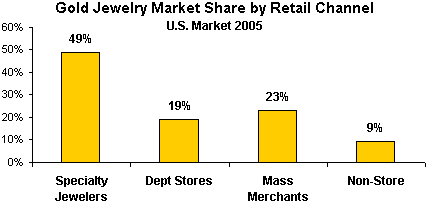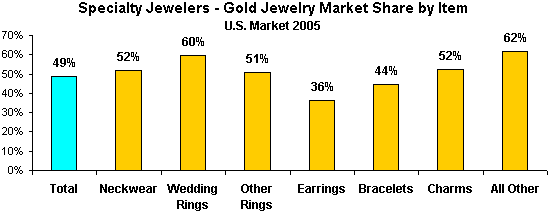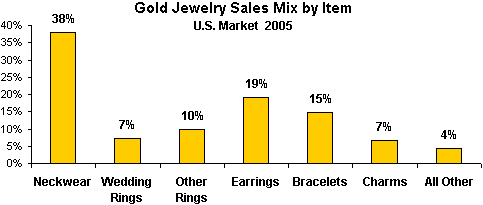IDEX Online Research: Who’s Got the Gold? Specialty Jewelers
July 30, 06
Specialty jewelers continue to dominate the gold jewelry market in the U.S., according to data recently released by the World Gold Council (WGC). Since 1993, specialty jewelers have sold almost half of all gold jewelry that is purchased by American consumers. Mass merchants and department stores each sell less than one-quarter of all gold jewelry (by value), while only about 9 percent of all gold jewelry is sold via non-store channels such as catalogs and the internet.
The graph below summarizes the retail jewelry market share that each major merchant had in 2005. For all practical purposes, the market share of each merchant category is basically unchanged since 1993.
|
|
The following table summarizes the gold jewelry market share data for the major retail distribution channels. With about $8.6 billion of gold jewelry sales, specialty jewelers sell about 49 percent of all gold jewelry in the U.S.

Source: World Gold Council
 Source: World Gold Council |
Bridal Jewelry: Specialty Jewelers’ Biggest Market
While specialty jewelers have just under 50 percent of the market for all gold jewelry, they have an even larger market share in the wedding ring category. For brides, specialty jewelers are by far the favorite place to buy gold wedding rings. Specialty jewelers such as Zale, Kay, and neighborhood independents sell about 60 percent of all wedding bands.
The graph below summarizes specialty jewelers’ gold jewelry sales by item.
|
|
Since 1993, specialty jewelers have essentially held their market share of each of the gold jewelry product categories, with the exception of gold earrings. In 1993, when the WGC began keeping these statistics, specialty jewelers had 45 percent of the market (by value) of gold earrings; this has declined to 36 percent, as shown on the graph above.
Department Stores Are a Major Outlet for Gold Jewelry
With an average retail unit price of over $135 in 2005, U.S. department stores are a major retail distribution channel for gold jewelry. The following graph summarizes market share of by item of gold jewelry. Bracelets and neckwear are two gold jewelry product categories where department stores excel. Wedding rings, earrings, and charms are less important product categories for department stores.
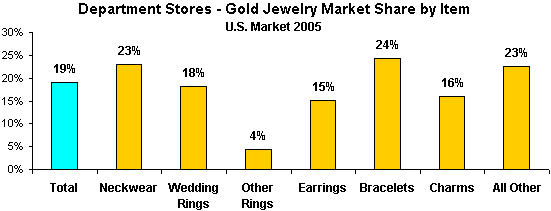 23% of all gold neckwear sales are made by department stores |
Mass Merchants Dominate Low-Priced Gold Jewelry Market
With an average retail unit-selling price of less than $35 in 2005, mass merchants dominate the market for low-priced gold jewelry. For example, mass merchants sell 37 percent of all gold jewelry earrings; these earrings have an average retail price of $21. Likewise, the average retail unit price for charms that mass merchants sell is about $23.
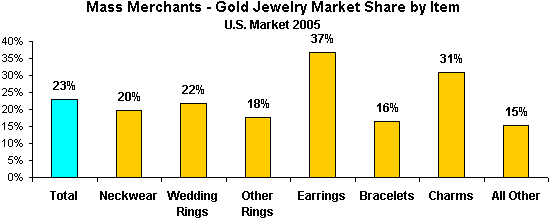 20% of all gold neckwear sales are made by mass merchants |
What’s Selling? Neckwear Is Most Popular Gold Jewelry
By far, more gold jewelry neckwear is sold than any other type of gold jewelry. About 38 percent – roughly two in five pieces – of all gold jewelry sold in the U.S. is a gold chain or other gold neckwear where gold represents the primary value of the piece. The graph below summarizes the sales mix by gold jewelry item in the U.S. market for 2005.
|
|
